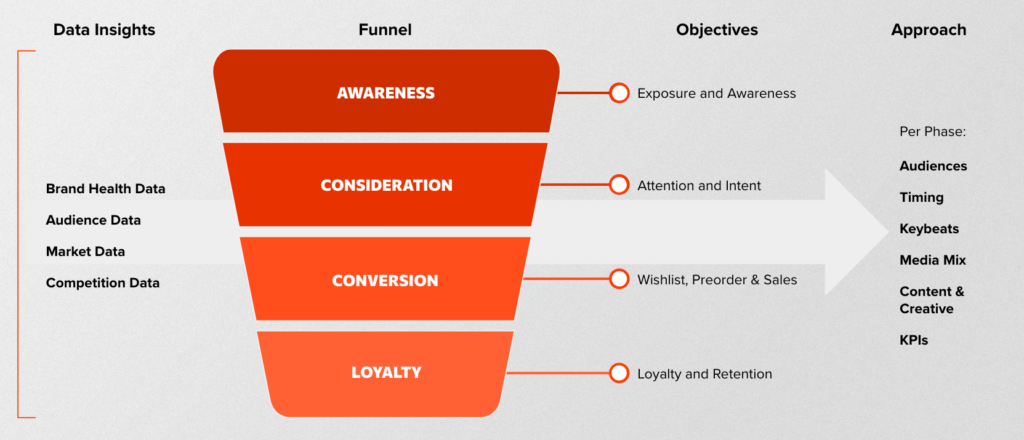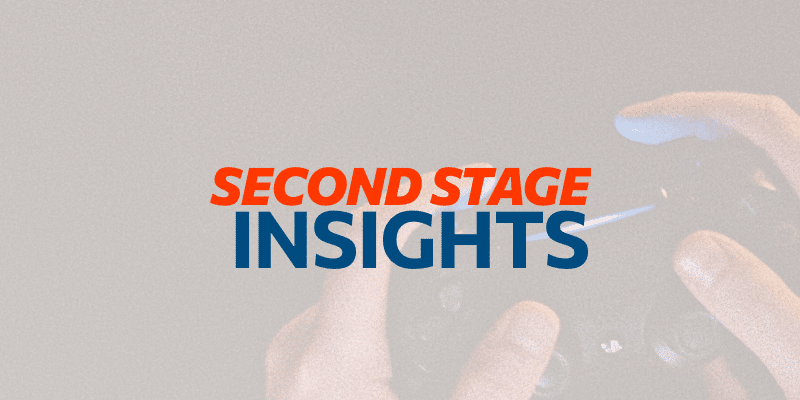In the fast-pacing gaming industry, understanding and catering to different stages of the gamer’s journey is crucial for success. Combining data-driven insights with a strategic approach to media planning significantly enhances the effectiveness of your media campaigns. This involves tailoring your media strategy to the three key stages of the gamer’s customer journey: awareness, consideration, and conversion – or what we also call the marketing funnel.

In this article, we explain how we choose the right media strategy for different objectives and deliver a tailor-made approach for individual campaigns, delivering on wishlists, preorders and sales.
Awareness: Capturing Gamers’ Attention
The primary goal at the awareness stage is to introduce your game to potential players. This is where you grab attention and make gamers aware of your game’s existence. Usually, this starts with the announcement of a game itself. Often during competitive times such as SGF or Gamescom, it is important to use data-driven insights to select granular audiences, ensuring the campaign can optimize and avoid spending against high-bidding competitors.
At this stage broad-reaching channels that are strong on video are the most important ones. Content needs to focus on a clear USP, creating an engaging and visually appealing asset that showcases the game’s unique features, storyline, and graphics.
At this stage, we measure success through impressions, reach, and brand health. These metrics indicate how many gamers have been exposed to your game and how well they remember it in comparison to competitive titles.
Consideration: Building Interest and Wishlists
At this stage, the goal is to build interest and persuade potential players to consider your game as a must-play. This involves providing more detailed information and engaging content that addresses gamers‘ preferences and excitement.
Implementing a strong landingpage enables us to track additional website data to build lookalike audiences for retargeting campaigns. Taking in the insights from initial campaign beats here we are mainly utilizing traffic campaigns to send users to platforms like Steam or PSN.
While some users move into the consideration stage of the funnel already, it’s also always important to find the right media strategy mix, running awareness and consideration campaigns at the same time. This comes into play when selecting the right channels, as some are quite strong to deliver on both sides. In addition to performance media, at this point of the campaign it’s also advised to focus a lot on strong content campaigns – detailed blog posts, gameplay trailers, developer diaries, and beta test invitations.
For consideration, we focus on engagement metrics such as click-through rates and website visits.
Conversion: Driving Preorders and Sales
The conversion stage is where the goal is to turn interested gamers into paying customers. This involves making it easy for them to take the desired action, such as preordering or purchasing the game.
To do so, we focus on conversion-driven channels and implement full-funnel-attribution tracking to connect ad clicks to game opens, enabling us to shine light on our return on ad-spend (ROAS), but also providing another dimension to optimizing campaigns based on sales.
For assets, it’s mandatory to provide clear, compelling CTAs, limited-time offers, early access incentives, and easy-to-navigate purchase processes. Emphasize the benefits of preordering, such as exclusive content or early access.
To make sense out of our activities, we look at conversion rates, cost per acquisition (CPA), and return on ad spend (ROAS). These metrics are crucial for understanding the effectiveness of your conversion efforts and the overall return on your marketing investments.
Key Takeaways
To maximize the impact of your media strategy, it’s essential to integrate efforts across all three stages and include important milestones. Here’s how:
- Awareness Tracking: In the initial phase of the campaign, track awareness by looking at engaged website visitors and use Brand Health Tracking to keep track of your brand performance against the competition.
- Data-Driven Adjustments: Use data from each stage to inform and adjust your strategy. For instance, insights from the awareness stage can help refine your targeting in the consideration stage.
- Attribution Tracking: Either through media-mix-modelling or full-funnel-attribution tracking, getting insights into the campaign ROAS is important to decide where budget is spent best – and reallocate between channels and GEOs when necessary to make the most out of it.
Adjusting your media strategy based on the stages of awareness, consideration, and conversion, along with key gaming milestones like wishlists, preorders, and sales, is crucial for effective digital marketing in the gaming industry. By understanding and addressing the specific needs of gamers at each stage, you can create a more personalized and impactful journey and drive better results for your game’s success.

